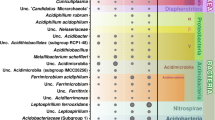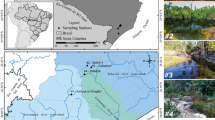Abstract
A combination of cultivation-based and molecular-based approaches was used to reveal the culturable and molecular diversity of the microbes inhabiting an open-dumped Pb/Zn mine tailings that was undergoing intensive acid generation (pH 1.9). Culturable bacteria found in the extremely acidic mine tailings were Acidithiobacillus ferrooxidans, Leptospirillum ferriphilum, Sulfobacillus thermotolerans and Acidiphilium cryptum, where the number of acidophilic heterotrophs was ten times higher than that of the iron- and sulfur-oxidizing bacteria. Cloning and phylogenetic analysis revealed that, in contrast to the adjacent AMD, the mine tailings possessed a low microbial diversity with archaeal sequence types dominating the 16S rRNA gene library. Of the 141 clones examined, 132 were represented by two sequence types phylogenetically affiliated with the iron-oxidizing archaea Ferroplasma acidiphilum and three belonged to two tentative groups within the Thermoplasma lineage so far represented by only a few environmental sequences. Six clones in the library were represented by the only bacterial sequence type and were closely related to the well-described iron-oxidizer L. ferriphilum. The significant differences in the prokaryotic community structures of the extremely acidic mine tailings and the AMD associated with it highlights the importance of studying the microbial communities that are more directly involved in the iron and sulfur cycles of mine tailings.




Similar content being viewed by others
References
Altschul SF, Gish W, Miller W, Myers EW, Lipman DJ (1990) Basic local alignment search tool. J Mol Biol 215:403–410
Baker BJ, Banfield JF (2003) Microbial communities in acid mine drainage. FEMS Microbiol Ecol 44:139–152
Bond PL, Smriga SP, Banfield JF (2000) Phylogeny of microorganisms populating a thick, subaerial, predominantly lithotrophic biofilm at an extreme acid mine drainage site. Appl Environ Microbiol 66:3842–3849
Brofft JE, McArthur JV, Shimkets LJ (2002) Recovery of novel bacterial diversity from a forested wetland impacted by reject coal. Environ Microbiol 4:764–769
Bryan CG, Hallberg KB, Johnson DB (2006) Mobilisation of metals in mineral tailings at the abandoned Sao Domingos copper mine (Portugal) by indigenous acidophilic bacteria. Hydrometallurgy 83:184–194
Coram NJ, Rawlings DE (2002) Molecular relationship between two groups of the genus Leptospirillum and the finding that Leptospirillum ferriphilum sp. nov. dominates South African commercial biooxidation tanks that operate at 40°C. Appl Environ Microbiol 68:838–845
De la Iglesia R, Castro D, Ginocchio R, van der Lelie D, Gonzalez B (2006) Factors influencing the composition of bacterial communities found at abandoned copper-tailings dumps. J Appl Microbiol 100:537–544
Diaby N, Dold B, Pfeifer HR, Holliger C, Johnson DB, Hallberg KB (2007) Microbial communities in a porphyry copper tailings impoundment and their impact on the geochemical dynamics of the mine waste. Environ Microbiol 9:298–307
Dojka MA, Hugenholtz P, Haack SK, Pace NR (1998) Microbial diversity in a hydrocarbon- and chlorinated-solvent-contaminated aquifer undergoing intrinsic bioremediation. Appl Environ Microbiol 64:3869–3877
Dopson M, Baker-Austin C, Hind A, Bowman JP, Bond PL (2004) Characterization of Ferroplasma isolates and Ferroplasma acidarmanus sp. nov., extreme acidophiles from acid mine drainage and industrial bioleaching environments. Appl Environ Microbiol 70:2079–2088
Duarte GF, Rosado AS, Seldin L, Keijzer-Wolters AC, van Elsas JD (1998) Extraction of ribosomal RNA and genomic DNA from soil for studying the diversity of the indigenous bacterial community. J Microbiol Methods 32:21–29
Edwards KJ, Gihring TM, Banfield JF (1999) Seasonal variations in microbial populations and environmental conditions in an extreme acid mine drainage environment. Appl Environ Microbiol 65:3627–3632
Fortin D, Davis B, Beveridge TJ (1996) Role of Thiobacillus and sulfate-reducing bacteria in iron biocycling in oxic and acidic mine tailings. FEMS Microbiol Ecol 21:11–24
Fortin D, Roy M, Rioux J, Thibault P (2000) Occurrence of sulfate-reducing bacteria under a wide range of physico-chemical conditions in Au and Cu-Zn mine tailings. FEMS Microbiol Ecol 33:197–208
Gabor EM, de Vries EJ, Janssen DB (2003) Efficient recovery of environmental DNA for expression cloning by indirect extraction methods. FEMS Microbiol Ecol 44:153–163
García-Moyano A, González-Toril E, Aguilera A, Amils R (2007) Prokaryotic community composition and ecology of floating macroscopic filaments from an extreme acidic environment, Río Tinto (SW, Spain). Syst Appl Microbiol 30:601–614
Golyshina OV, Pivovarova TA, Karavaiko GI, Kondrateva TF, Moore ER, Abraham WR, Lunsdorf H, Timmis KN, Yakimov MM, Golyshin PN (2000) Ferroplasma acidiphilum gen. nov., sp. nov., an acidophilic, autotrophic, ferrous-iron-oxidizing, cell-wall-lacking, mesophilic member of the Ferroplasmaceae fam. nov., comprising a distinct lineage of the Archaea. Int J Syst Evol Microbiol 50:997–1006
Golyshina OV, Timmis KN (2005) Ferroplasma and relatives, recently discovered cell wall-lacking archaea making a living in extremely acid, heavy metal-rich environments. Environ Microbiol 7:1277–1288
Good IJ (1953) The population frequencies of species and estimation of population parameters. Biometrika 40:237–264
Hallberg KB, Johnson DB (2003) Novel acidophiles isolated from moderately acidic mine drainage waters. Hydrometallurgy 71:139–148
Hawkes RB, Franzmann PD, Plumb JJ (2005) Moderate thermophiles including Ferroplasma cyprexacervatum sp. nov. dominate an industrial-scale chalcocite heap bioleaching operation. In: Harrison STL, Rawlings DE, Petersen J (eds) Proceedings of the sixteenth international biohydrometallurgy symposium, pp 657–666
Hawkes RB, Franzmann PD, O’hara G, Plumb JJ (2006) Ferroplasma cupricumulans sp. nov., a novel moderately thermophilic, acidophilic archaeon isolated from an industrial-scale chalcocite bioleach heap. Extremophiles 10:525–530
Johnson DB, Bridge TAM (2002) Reduction of ferric iron by acidophilic heterotrophic bacteria: evidence for constitutive and inducible enzyme systems in Acidiphilium spp. J Appl Microbiol 92:315–321
Kock D, Schippers A (2006) Geomicrobiological investigation of two different mine waste tailings generating acid mine drainage. Hydrometallurgy 83:167–175
Rawlings DE, Tributsch H, Hansford GS (1999) Reasons why ‘Leptospirillum’-like species rather than Thiobacillus ferrooxidans are the dominant iron-oxidizing bacteria in many commercial processes for the biooxidation of pyrite and related ores. Microbiology 145:5–13
Schippers A, Hallmann R, Wentzien S, Sand W (1995) Microbial diversity in uranium mine waste heaps. Appl Environ Microbiol 61:2930–2935
Schloss PD, Handelsman J (2005) Introducing DOTUR, a computer program for defining operational taxonomic units and estimating species richness. Appl Environ Microbiol 71:1501–1506
Silver M (1987) Distribution of iron-oxidizing bacteria in the Nordic uranium tailings deposit, Elliot Lake, Ontario, Canada. Appl Environ Microbiol 53:846–852
Singleton DR, Furlong MA, Rathbun SL, Whitman WB (2001) Quantitative comparisons of 16S rRNA gene sequence libraries from environmental samples. Appl Environ Microbiol 67:4374–4376
Southam G, Beveridge TJ (1992) Enumeration of Thiobacilli within pH-neutral and acidic mine tailings and their role in the development of secondary mineral soil. Appl Environ Microbiol 58:1904–1912
Tan GL, Shu WS, Hallberg KB, Li F, Lan CY, Huang LN (2007) Cultivation-dependent and cultivation-independent characterization of the microbial community in acid mine drainage associated with acidic Pb/Zn mine tailings at Lechang, Guangdong, China. FEMS Microbiol Ecol 59:118–126
Tsai YL, Olson BH (1991) Rapid method for direct extraction of DNA from soil and sediments. Appl Environ Microbiol 57:1070–1074
van de Vossenberg JLCM, Driessen AJM, Zillig W, Konings WN (1998) Bioenergetics and cytoplasmic membrane stability of the extremely acidophilic, thermophilic archaeon Picrophilus oshimae. Extremophiles 2:67–74
Wielinga B, Lucy JK, Moore JN, Seastone OF, Gannon JE (1999) Microbiological and geochemical characterization of fluvially deposited sulfidic mine tailings. Appl Environ Microbiol 65:1548–1555
Yang B, Shu WS, Ye ZH, Lan CY, Wong MH (2003) Growth and metal accumulation in vetiver and two Sesbania species on lead/zinc mine tailings. Chemosphere 5:1593–1600
Acknowledgments
This research was funded by the National Natural Science Foundation of China (30100024) and Key Project of the Ministry of Education of China (031280). We thank the two anonymous reviewers for their constructive comments on the manuscript.
Author information
Authors and Affiliations
Corresponding author
Additional information
Communicated by T. Matsunaga.
Rights and permissions
About this article
Cite this article
Tan, GL., Shu, WS., Hallberg, K.B. et al. Culturable and molecular phylogenetic diversity of microorganisms in an open-dumped, extremely acidic Pb/Zn mine tailings. Extremophiles 12, 657–664 (2008). https://doi.org/10.1007/s00792-008-0171-9
Received:
Accepted:
Published:
Issue Date:
DOI: https://doi.org/10.1007/s00792-008-0171-9




